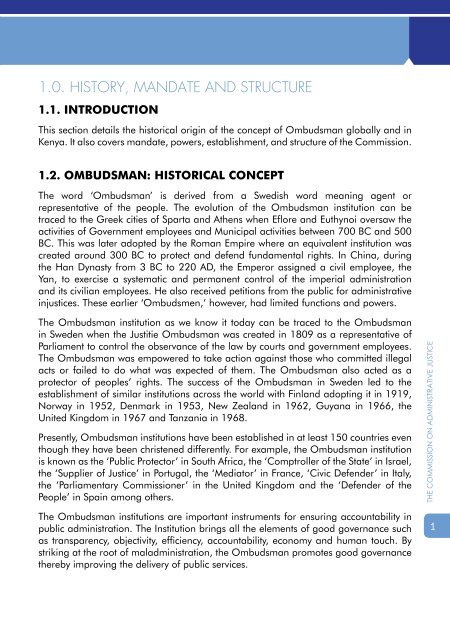ADMINISTRATIVE
CAJ-Annual-Report-2014
CAJ-Annual-Report-2014
Create successful ePaper yourself
Turn your PDF publications into a flip-book with our unique Google optimized e-Paper software.
1.0. HISTORY, MANDATE AND STRUCTURE<br />
1.1. INTRODUCTION<br />
This section details the historical origin of the concept of Ombudsman globally and in<br />
Kenya. It also covers mandate, powers, establishment, and structure of the Commission.<br />
1.2. OMBUDSMAN: HISTORICAL CONCEPT<br />
The word ‘Ombudsman’ is derived from a Swedish word meaning agent or<br />
representative of the people. The evolution of the Ombudsman institution can be<br />
traced to the Greek cities of Sparta and Athens when Eflore and Euthynoi oversaw the<br />
activities of Government employees and Municipal activities between 700 BC and 500<br />
BC. This was later adopted by the Roman Empire where an equivalent institution was<br />
created around 300 BC to protect and defend fundamental rights. In China, during<br />
the Han Dynasty from 3 BC to 220 AD, the Emperor assigned a civil employee, the<br />
Yan, to exercise a systematic and permanent control of the imperial administration<br />
and its civilian employees. He also received petitions from the public for administrative<br />
injustices. These earlier ‘Ombudsmen,’ however, had limited functions and powers.<br />
The Ombudsman institution as we know it today can be traced to the Ombudsman<br />
in Sweden when the Justitie Ombudsman was created in 1809 as a representative of<br />
Parliament to control the observance of the law by courts and government employees.<br />
The Ombudsman was empowered to take action against those who committed illegal<br />
acts or failed to do what was expected of them. The Ombudsman also acted as a<br />
protector of peoples’ rights. The success of the Ombudsman in Sweden led to the<br />
establishment of similar institutions across the world with Finland adopting it in 1919,<br />
Norway in 1952, Denmark in 1953, New Zealand in 1962, Guyana in 1966, the<br />
United Kingdom in 1967 and Tanzania in 1968.<br />
Presently, Ombudsman institutions have been established in at least 150 countries even<br />
though they have been christened differently. For example, the Ombudsman institution<br />
is known as the ‘Public Protector’ in South Africa, the ‘Comptroller of the State’ in Israel,<br />
the ‘Supplier of Justice’ in Portugal, the ‘Mediator’ in France, ‘Civic Defender’ in Italy,<br />
the ‘Parliamentary Commissioner’ in the United Kingdom and the ‘Defender of the<br />
People’ in Spain among others.<br />
THE COMMISSION ON <strong>ADMINISTRATIVE</strong> JUSTICE<br />
The Ombudsman institutions are important instruments for ensuring accountability in<br />
public administration. The Institution brings all the elements of good governance such<br />
as transparency, objectivity, efficiency, accountability, economy and human touch. By<br />
striking at the root of maladministration, the Ombudsman promotes good governance<br />
thereby improving the delivery of public services.<br />
1


